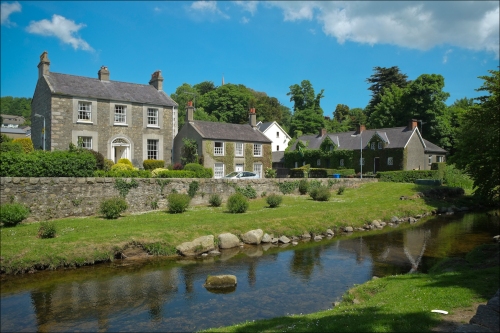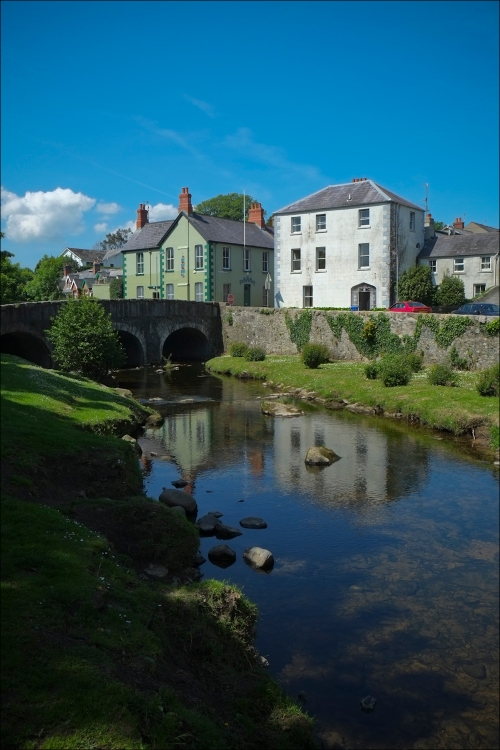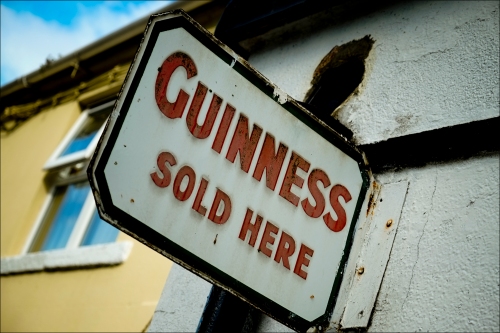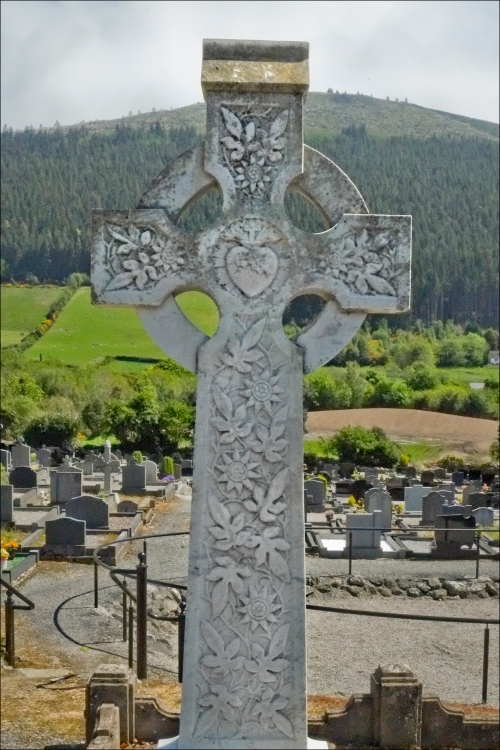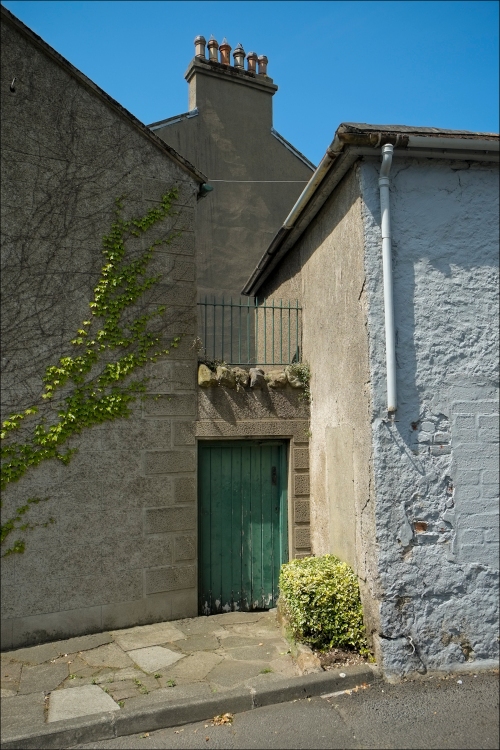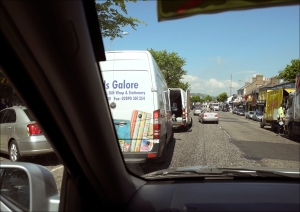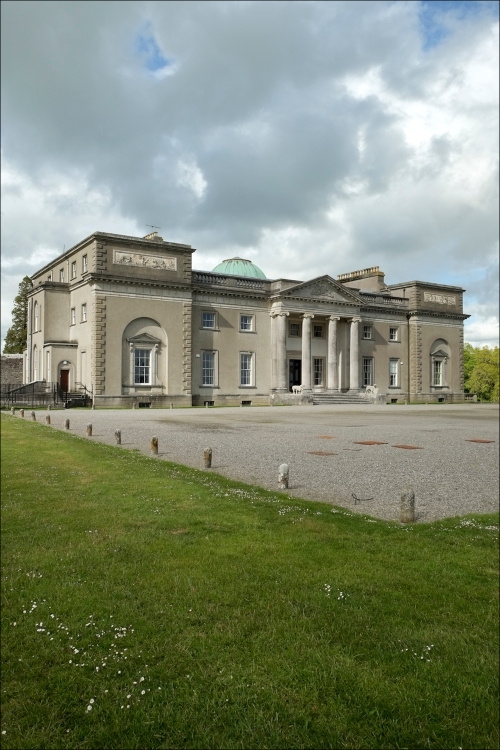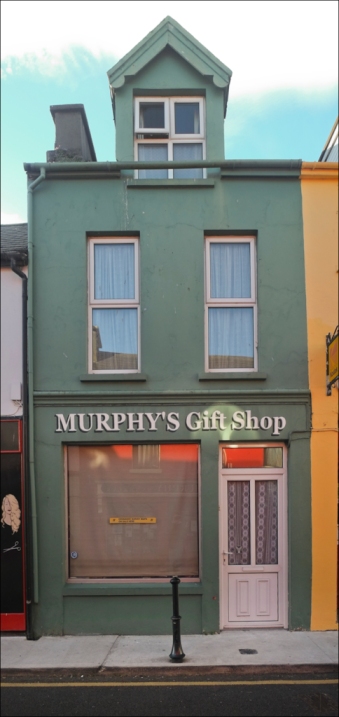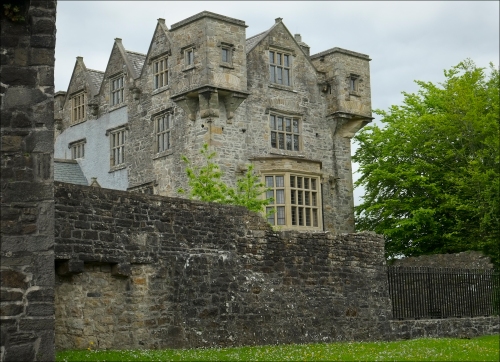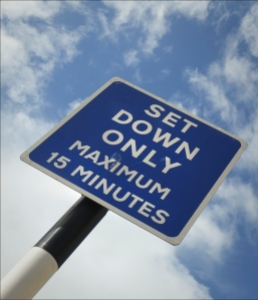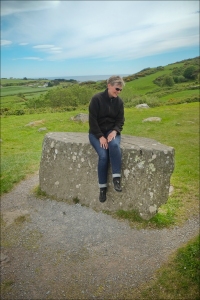Those of you that have followed the blog for a while know that I have ambivalent feeling about graffiti. Sometimes I think that spray paint should be universally outlawed, but then, occasionally, you can’t help but smile.
Alicante
Alicante is our favorite coastal city, so far! This historic Mediterranean port has a population of about 400,000. Since the 3rd century BC it has been invaded and conquered by cocky Carthaginians, rapacious Romans, vicious Visigoths, moody Moors, clobbering Castilians, volatile Valencians, rascally Republicans, nasty Nationalists and finally an Armada of Cruise Liners.
The bustling core of the old city sits right on the waterfront and is full of wide palm tree shaded walking arcades, great historic buildings and a labyrinth of narrow streets and open air markets.
Alicante has two, not to be missed, art museums. Both El Museo de Bellas Artes Gravina (MUBAG) and the Museum of Contemporary Art of Alicante (MCAA) are terrific museums that are the perfect size, big enough to be really interesting and small enough to be experienced in a couple hours. And they’re free. They both house great Spanish collections and, like all great museums, the buildings themselves are terrific works of art.
Bye for now. We’re going to go drink a little.
Somebody’s Big Day
I was walking around the Basilica of Santa Maria in Alicante when a BMW pulled up and unloaded the bride. I guess you have been a photographer far too long when you see a random wedding of complete strangers and you feel compelled to leap up and swing into action. I really couldn’t stop myself.
Oropesa del Mar
We have finally recovered from jet lag and have begun to explore the area. Took our first trip was to Oropesa, an interesting little seacoast city, which, like every other city in the region, is waiting with baited breath for the tourist season to start.
As you can see the beaches are deserted. It was a beautiful day and the only people frolicking in the sand were an elderly couple, one topless sunbather and two boys playing hooky.
There are literally miles of beaches and locals assure me that in about three weeks every one of them will be packed like a can of sardines with all manner of British and German tourists. You’ll have a hard time finding space to spread out a towel.
The southern coast of Spain has got to be Dean Martin’s spiritual home. Almost every bit of coast we’ve seen is lined with vintage high rise apartment complexes dating from the fifties to the early eighties.
Bye for now. We’re going swimming.
Hasta Luego.
No Turning Back
Our 2014 home exchange has begun in earnest and I’ve decided that it’s a little like international skydiving. All the pictures and planning in the world won’t save you. You’re not exactly sure what you’ve gotten into until you’re plummeting towards earth at breakneck speed. In the end it’s just an act of faith. Regardless of any turbulence you encounter on the way down, you have to trust that the parachute will open and you’ll land softly on firm ground.
This trip is no different. It began calmly enough. We met our fellow exchangers, Magda and Manolo, at SeaTac. A lovely couple, full of energy and rip roaring ready to go. After they treated us to dinner we exchanged hugs, set the GPS to home and sent them on their way.
Then it was a hour through security, another hour at the gate and nine hours on Lufthana. We arrived in Frankfurt, Germany completely toasted, only to discover that Booking.com had us reserved for August 3rd instead of June 3rd. The story has both a good and bad ending. The good part was that the Hilton next door had a room, unfortunately it costs three times as much as the first room. Oh well, that’s the way the bee bumbles.
The next day’s flight to Valencia was perfect. Magda’s brother, Vicent, drove us to Benicasim and had us set up in no time. The only thing left to do now is recover.
Farewell to Rostrevor
As night falls on our home exchange let’s take a final look at Rostrevor, the lovely little town in Northern Ireland that we’ve called home for the last month.
Kilbroney Park
Rostrevor is dominated by hugely popular Kilbroney Park.A lovely 97 acre park that starts on the shores of Carlingford Lough and runs 1000′ up the side of Slieve Martin. [portfolio_slideshow id=1622]
Fairy Glen
Fairy Glen is a mile long trail that runs between the town and Kilbroney Park. Tradition has it that the Fairy Glen was the home to many of the “wee folk”. Residents were careful not to use this route after dark as it was widely believed that the fairies could be heard dancing to otherworldly music.
- Fairy Glen
Thristy?
One thing I discovered about Rostrevor is that you won’t die of thrist here.
- The Glenside inn
- Irish National Foresters Hall
- Fearon’s
- The Killiwen Inn
- P. G. Tinnelly
- The Kilbrony
- Patrick Crawford
- Celtic Fjord
- The Corner House Bar
- The Cloughmore Inn
Rostrevor Cemetery
A trip to Rostrevor wouldn’t be complete without a stop at Rostrevor Cemetery, the final resting place of Patrick Murphy, who in 1862 was considered the world’s tallest man. He billed himself as being 8’10” and in some circles as much as 9’3″. His height is debated today, but regardless, he was big. Real big.
- Rostrevor Cemetery
- Celtic Crosses
- Patrick Murphy
- Patrick Murphy’s Grave
We’re slipping out the back door now. Thanks for tuning in.
Lovely Country Lanes or Death Defying Thoroughfares?
We’ve been to Turkey and thought that the driving was totally insane. The completely chaotic behavior of the drivers, the narrowness of the roads and the blaring horns left us rattled to the core. Then we came to Ireland and you know what? The Turks aren’t so bad.
Part of the problem is expectations. Every travel book we’ve read depicts SW Ireland as a land filled with lovely idyllic country roads and romantic windy lanes that fill the heart with joy and a longing for a simpler time when life moved slower and the whole world felt at peace. And it is.
What they neglected to inform us was that these 12’ wide roads can have speed limits as high as 80 kmh and are clogged with all manner of motor vehicles including SUVs, utility vans, cars dragging travel trailers, RVs, 35’ tour buses and 18 wheel freight trucks. And they’re used to it so you damn well better get out of the way. At a B&B in Kilkenny it was explained to us that the width of roads in Ireland was dictated by royal decree to be at least the width of two cows!
- 12′ wide, no center line and no shoulder.
- If you drove this road at the 80 kmh speed limit you’d be careening around corners on two wheels.
- There is a lot of truck traffic on this road. You just get out of the way. Quickly!
- This road is under 12′ wide, has a 80 kmh speed limit and is opened to two way traffic, including tour buses.
- Yes, this is a registered two way road.
- Speed Limit 30 kmh
We were asked to get an insurance rider when we got here. Oh yea, I get it now. And did I mention they drive on the wrong side of the road.
Office of Public Works
We were so pleased with our English National Trust cards that we looked for an Irish equivalent and discovered the OPW, Office of Public Works. The OPW handles over 100 heritage properties in Ireland and the cards, at 16 euros each, is the bargain of the century. It’s true that we may very well be crass American self promoters, but we had to tell them that Office of Public Works is probably not the most promotion savvy name they could have chosen.
Springhill House
Col. George Lenox served in the Irish Volunteers but, after being betrayed by Lord Castlereagh, resigned his commission in disgrace in 1816. As a result of this, combined with his depressive nature, he committed suicide later that year. His wife Olivia is said to haunt the house to this day and is Ireland’s most documented ghost.
- Springhill House
- Stables with Dutch gables
- Courtyard at Springhill House
- Courtyard at Springhill House
- Courtyard at Springhill House
- William Conyngham II and Ann Upton
- Sitting Room at Springhill House
- Wooded path at Springhill House
- Springhill House
Emo Court
Built in 1790 for John Dawson, the first Earl of Portarlington. The Earl died before it’s completion and it has passed through many hands until the outbreak of the First World War in 1914 when the family left for England. It remained unoccupied until 1930 when the house was acquired by the Jesuits. One of the first priests to live here was Father Francis Browne, best known as a brilliant photographer who left behind a definitive record of Irish life during the first half of the 20th century.
Barryscourt Castle
This site has been occupied for over a thousand years. The tower fortress was the home to the Anglo-Norman de Barry family from the 12th century. It may look lovely in the sunshine but to call it a home is a real stretch. It’s primary function was safety not comfort. It was intentionally designed to be very difficult to get in and out of with only one small door, narrow, steep and uneven stone stairways, murder holes and a very nasty little dungeon. It was crowded, damp, smelly, dirty, smokey, drafty and very cold.
- Barryscourt
- Barryscourt
- Barryscourt
Trim Castle
A large Fortress Tower Castle that’s most recent claim to fame is as a location for Braveheart.
- The gatehouse at Trim Castle
- Trim Castle
- Trim Castle
- The view from Trim Castle
Castletown
William Conolly, Speaker of the Irish House of Commons and a Commissioner of the Revenue, was the wealthiest man in Ireland in 1694 when he married Katherine Conyngham. They built Castletown together and William specified that every part had to be made from Irish materials, a fact that would save the property from Nationalist firebombs during the war for independence. Unfortunately William died in 1729, the same the year the house was finished, and never got to enjoy it. But Katherine sure did. She remained in Castletown until her death in 1754 and in order to retain her previous social status after William’s death, she began to spend money at a staggering pace. The parties and drinking were legendary. The combined brewing and vintner bills averaged approximately 600 pounds a year, about $60,000 in today’s money. Katherine, not willing to turn her fortune over to a new man, never remarried. Society ladies criticized her for riding her carriage through the countryside, “too fast and with numerous young men”.
- Castletown House was Ireland’s first winged Palladian home.
- 18th century Italian chandeliers.
- Wooded path.
- 550 acre estate
Kilkenny
We really loved Kilkenny. One of the most vibrant and interesting cities we visited. The Kilkenny Castle and the Art & Design Center create a wonderful cultural hub.
- Kilkenny Castle
- Kilkenny Design Center
- New Building Lane
- Smithwick Brewery
- Public Notice.
- Market Slip
- Irishtown area near Black Abbey Lane.
- Classic pubs are everywhere.
- Elvis’ spiritual home
- I have no idea what it says!
- Kilkenny Castle
Muchross House
One of Ireland’s premier Tudor style mansions, Muckross House was built in 1843 for Henry Arthur Herbert and his wife, the excellent watercolourist Mary Balfour Herbert. Extensive and hugely expensive improvements were undertaken in the 1850s in preparation for the visit of Queen Victoria in 1861. The Herberts were gambling that the Queen would give him a peerage that would correct his failing fortunes. When the Queen returned to London, Prince Albert died, and she quickly forgot all about the Herberts. The cost of these improvements aggravated the Herbert’s financial difficulties and resulted in the sale of the estate.
- Muckross House
- Muckross House
- Muckross House
- View From Muckross House
- View From Muckross House
Aughnanure Castle
This fine example of an Irish Tower Fortress was the family home of Donal O’Flaherty who in 1546 married Grace O’Malley. After Donal’s murder, Grace fled to the family island of St. Claire off the western coast of Ireland and began a lifelong career as the 16th century’s most notorious pirate.
- Aughnanure Castle
- Aughnanure Castle
- Horses At Aughnanure Castle
- Horses At Aughnanure Castle
Tintern Abbey
The present-day remains of Tintern are a mixture of building works covering a 400-year period between 1136 and 1536. In the reign of King Henry VIII, his Dissolution of the Monasteries ended monastic life in England and Wales. On 3 September 1536 Abbot Wyche surrendered Tintern Abbey and the valuables from the Abbey were sent to the royal Treasury. Lead from the roof was sold and the decay of the buildings began.
- Tintern Abbey
- Tintern Abbey
- Tintern Abbey
- View From Tintern Abbey
- Footbridge At Tintern Abbey
- Wooded Path At Tintern Abbey
Drombeg Stone Circle
Also known as the Druid’s Altar, the site was excavated and restored in 1958. A pot was discovered containing the cremated remains of a young adolescent dating from 945 – 830 BC.
- Drombeg Stone Circle
- View from Drombeg Stone Circle
- View from Drombeg Stone Circle
- View from Drombeg Stone Circle
- Drombeg Stone Circle
Hook Head Lighthouse
Hook Head, the oldest lighthouse in Ireland, is said to have found its way into common English usage in the expression “By Hook or by Crook.” It is claimed that Oliver Cromwell vowed to take Waterford by Hook (on the Wexford side of the estuary) or by Crook (a village on the Waterford side).
- Hook Head Anchor
- Hook Head Anchor
- Hook Head Anchor
- Hook Head Anchor
Castletownbere
Castletownbere Harbour was developed as the major fishing port on the Beara Peninsula. Although, like many small communities, Castletownbere has been hit hard by the economic downturn.
- TallonRd
- Grumpy Mama
- Murphy’s Salon
- Murphy’s Barber Shop
- Seaview Bar
- I Have No Idea
- Castletownbere
- Castletownbere
- Silver Dollar Bar
- These Wee Folk Are Everywhere.
- Mary Rose
Besides the usually smattering of imigrants, there appear to be three major clans in Castletownbere, the O’Sheas, the O’Sullivans and the Murphys. The Murphys are by far the most prodigious. There is Murphy’s Funeral Home, Murphy’s Boat Hauling, Murphy’s Fishing, Murphy’s Restaurant, Murphy’s Pub, Murphy’s Fish & Chips, Murphy’s Florist, Murphy’s Party Supplies, Murphy’s Gift Shop and, of course, Murphy’s Irish Stout.
Donegal Castle
The elder Sir Hugh O’Donnell, wealthy chief of the O’Donnell clan, built the castle in 1474. In 1607, after the Nine Years war the leaders of the O’Donnell clan left Ireland in the Flight of the Earls. In 1611 the castle and its lands were granted to an English Captain, Basil Brooke. The keep had been severely damaged by the departing O’Donnells to prevent the castle being used against the Gaelic clans.
Slanglish
People here don’t speak English. They speak Slanglish and have great fun with the language. Sometimes there are so many rhyming couplets, alliterations and just nonsense words that I have a hard time figuring out what anyone is talking about. I’m certain that my English friends could send me books full of this stuff, but I’ll just mention a few that I hear everyday.
Cheers
I’ve heard the expression “cheers” for many years, but I had no idea that is a completely all purpose word that can mean, among other things, thank you, congratulations, your welcome, hello, goodbye, good day, good morning or good afternoon. It can be used singularly or in combination with its root meaning, as in “Cheers, thanks” or “Cheers, goodbye”. Which, to my ear sounds a bit redundant, like “thanks, thanks” or “goodbye, goodbye”. But if you use cheers as a verb or in the past tense it reverts to its more traditional meaning. You might say that you had thanked someone, where as you could never say that you had cheers’d someone.
Wee
Everything is wee. We’re in a wee country, in a wee county, in a wee village, where we’re going for a wee walk to have a wee bit of lunch at a wee restaurant. And the subject doesn’t necessarily have to be small or charming. The only thing I haven’t heard wee combined with is wee, as in wee wee.
Ha Ha
Although there is no wee wee there is a Ha-Ha. This 16th or 17th century invention, is a reinforced trench that stretches across a field or pasture and works like a fence that keeps sheep and cattle from wandering near the manor. But unlike a fence, it does not disrupt the vista and is almost invisible when viewed from the house out. The name refers to what you might exclaim if you stumbled across it by accident, although you’d more likely say “call 911!”
Londonderry
In 1613 the British rulers selected Derry as the site for one of their infamous “plantation” projects. Under the control of London livery companies they renamed the town Londonderry. Locals have never really taken to the name as it was seen to symbolize foreign rule and regardless of what the road signs say, have continued to call it Derry for 400 years. Recently, in an attempt at political correctness, authorities have hyphenated the name to “Derry-Londonderry”. Over here the hyphen is referred to as a stroke so now it’s become “Stroke City”.
A Miscellaneous Few
A room that had a window at eye level was referred to as a “tippy toe room”.
When searching through a junk shop we were encouraged to “have a wee nosey”.
When a tour guide was off talking to someone else, we were asked to wait as he was “having a wee bit of a gnash at the minute”.
If you need time to think about something you might have “a wander and a ponder”.
Lunch would be a “rumble corrector”.
Giving something a try might be “taking a punt”.
And needing to hurry up would be to “Get A Tic Toc On”.
The Wendi Files – Part 2
The Wacky Wendi Saga Continues.
- With Pete
- Welcome
- Lost And Alone
- A Little Scary
- More Bus Fun
- Double Decker
- Inspecting Another Fortress
- Dinner In Castletownbeare
- Dizzy
- Druid Sacrifice
- With Bertha
- To The Manor Born
- Outstanding In Her Field
- A Little Big
- Perfect
- Irish Ferry
- Temple Bar – Dublin
- The Wee Folk Museum
- Katherine In Kilkenny
- Our B&B In Port Issac
- Prawns?
- Ace Shopper
- Pie Lust
- Tintern Abbey
- London
- One Too Many
Damn, I like that girl!











































